Laparoscopic Surgery
Laparoscopic Surgery is also known as key-hole surgery or minimal invasive surgery. Instead of making a large incision (or cut) for certain operations, surgeons usually make 3-4 tiny incision and insert thin instruments and a camera into an area.
The procedure is performed in the following way:
- The surgeon makes a small cut (incision) below the belly button (navel).
- A needle or tube is inserted into the incision. Carbon dioxide gas is passed into the abdomen through the needle or tube. The gas helps expand the area, giving the surgeon more room to work, and helping the surgeon see the organs more clearly.
- A tube is placed through the cut in abdomen. A tiny video camera (laparoscope) goes through this tube and is used to see the inside of your pelvis and abdomen. More small cuts may be made if other instruments are needed to get a better view of certain organs.
- In case of gynaecologic laparoscopy, dye may be injected into cervix area so the surgeon can view your fallopian tubes.
- After the exam, the gas, laparoscope, and instruments are removed, the cuts are closed and bandages placed over those areas.
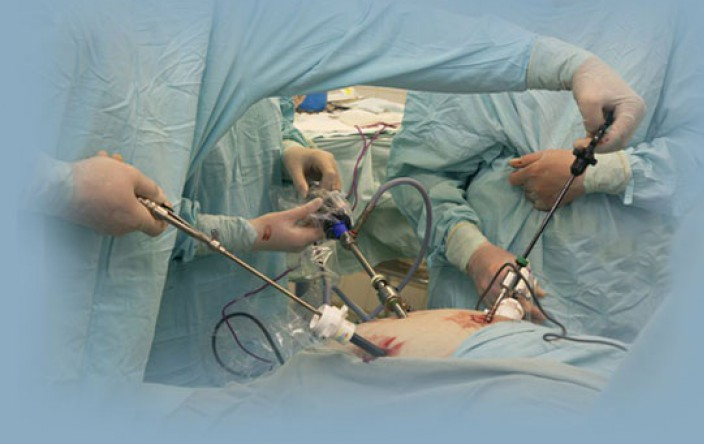
Laparoscopic Surgery
Our Laparoscopic surgery department is well equipped with modern equipments supported by qualified and experienced team of surgeons. We are the pioneer in Laparoscopic Surgery in West Bengal (after Kolkata and Siliguri). You will be glad to know that we are performing Laparoscopy since 1995 with outstanding rate of success. The department specializes in performing all major surgeries involving abdomen viz. Gallbladder stone, Appendicectomy, Hysterectomy, Ovarian cystectomy etc. Patients receive specialized assessment, latest treatments along with clinical post-operative care, medications and a regular follow-up.
Laparoscopic Cholecystectomy
It is a minimally invasive surgical procedure to remove gallbladder stone.
Advantage:
- Patients usually have minimal Post-Operative Pain.
- Patients usually experience faster recovery then open gallbladder surgery patients.
Laparoscopic Appendectomy
It is a minimally invasive surgical procedure to removing appendix.
Advantage:
- Less post-operative pain.
- May shorten hospital stay.
- Better cosmetic result : 5mm telescope given for less narrow incision.
Laparoscopic Hysterectomy
It is a minimally invasive surgical procedure to remove the uterus.
Advantage:
- Less post-operative pain.
- Less post-operative bleedings.
- Less risk of blood loss and infection.
- Better cosmetic result.
Diagnostic Laparoscopy
Diagnostic laparoscopy is minimally invasive surgery for the diagnosis of intra-abdominal diseases. The procedure enables the direct inspection of large surface areas of intra-abdominal organs and facilitates obtaining biopsy specimens, cultures, and aspiration. Diagnostic laparoscopy not only facilitates the diagnosis of intra-abdominal disease but also makes therapeutic intervention possible. There are various reasons why diagnostic laparoscopy may be recommended.
- 1. Diagnostic laparoscopy helps identify the cause of pain or a growth in the abdomen and pelvic area. It is done if x-rays or ultrasound results are unclear.
- 2. The procedure may also be done instead of open surgery after an accident to see if there is any injury to the abdomen.
- 3. Laparoscopy may be done before procedures to treat cancer (such as surgery to remove an organ), to find out whether the cancer has spread. If it has spread, treatment will change.
Laparoscopic Ovarian Cystectomy
It is a minimally invasive surgical procedure to remove Ovarian Cysts.
Laparoscopic Dye test
It is an important investigation in the evaluation of infertile women to explore abnormality or blockage in fallopian tube. Due to the high prevalence of tuboperitoneal factor and additional pelvic pathology in these infertile women use of laparoscopic dye test is first line investigation to detect these conditions early enough when treatment modalities like assisted reproduction will still be beneficial.
We have latest state-of-the-art medical instruments like-
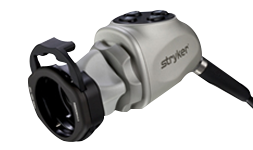
HD 3-chip camera
(a) HD 3-chip camera: The HD Camera System utilizes advanced technology and premium optics for best-in-class video systems that provides clear bright image designed to enhance patient outcomes.
(b) HD Telescope Precision IE: Made with high quality sapphires and latest rod lens technology for excellent details recognition, colour rendering, resolution and superior image quality. Advantage of 5mm diameter over conventional 10 mm diameter require smaller port means virtually scar less surgery.
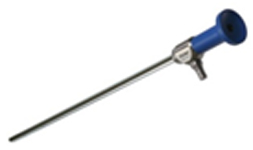
Precision IE

Harmonic-Scalpel
(c) Harmonic Scalpel & ENSEAL: This is a New Generation surgical instrument used to simultaneously coagulate and cut tissue using ultrasonic power. A Harmonic scalpel cuts via vibration. The scalpel surface itself cuts through tissue by vibrating in the range of 55,500 Hz. The high frequency vibration of tissue molecules generates stress and friction in tissue, which generates heat and causes protein denaturation. This technique causes minimal energy transfer to surrounding tissue, potentially limiting collateral damage. ENSEAL helps coagulating & transecting blood vessels up to 7mm in diameter.
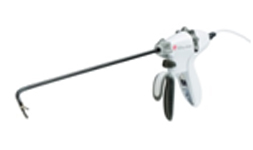
EnSeal-Articulating-Tissue-Sealer
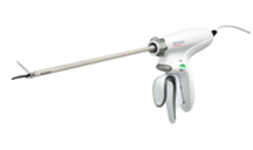
EnSeal-Super-Jaw
Advantages of Harmonic Scalpel over conventional electro cautery :
- Reduced operative time and faster recovery. The Harmonic scalpel allows dissection and closure of the cystic artery and ducts < 4–5 mm in diameter without requiring clipping.
- Doesn’t require for frequent instrument change during operation.
- Greater visibility due to the absence of surgical smoke in the operative field.
- Unlike electro cautery no electricity passed, hence safer due to less tissue damage and chances of accidental bowel injury.
- Less bleeding due to ability to close vessels < 7 mm diameter without clipping.
- Reduced risk of conversion to open surgery.
Disadvantages of Harmonic scalpel :
- Considerably higher cost of operation.
- Smaller incision, which reduces pain and shortens recovery time. Patients can return to everyday living and join work sooner.
- Minimal post operative scarring, pain and trauma.
- Lesser hospital stay (only 2-3 days) which leads to lesser post operative cost.
- Less bleeding which reduces the chance of blood transfusion.
- Reduced exposure of internal organs to possible external contaminants thereby reduced risk of acquiring infections.
For further enquiries please contact with us.